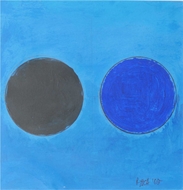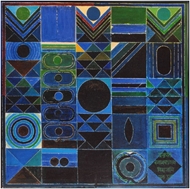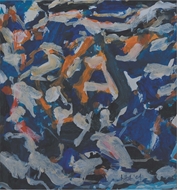![]() Significant Indian Art
Significant Indian Art
![]() Significant Indian Art
SYED HAIDER RAZA (1922 - 2016)
Significant Indian Art
SYED HAIDER RAZA (1922 - 2016)
RELATED LOTS
CONTACT US
Catalogue & Viewing
Lot Closed
Accounts & Shipping
Lot Closed
-
Provenance
 Provenance
Provenance
PROPERTY OF A GENTLEMAN, MUMBAI
-
Literature
 Literature
Literature

“My present work is the result of two parallel enquiries. Firstly, it aimed at pure plastic order, form order. Secondly; it concerns the theme of Nature. Both have converged into a single point and become inseparable; the point, the bindu, symbolises the seed, bearing the potential of all life…” - S. H. Raza
In his Bindu series of paintings Raza resorts to the principles that govern pictorial language - the essential vocabulary of the point, line, diagonal, circle, square and triangle. His concern remains solely in the sanctified significance of pure geometry - a "complete sensory experience".
As a young artist Raza was inspired by the research into Indian traditional art forms initiated by artists like Abanindranath, Nandalal Bose, Jamini Roy and Amrita Sher Gill. It had been a paradox to the nuances of academic European art that he was exposed to in art schools that trained to see the world through the ‘retina’ as opposed to the Indian concept of visualising through the inner eye or third eye that led to ‘antar-jyoti’ or ‘antargyan’ (self-realization).
By the end of the 1970s Raza had become increasingly dissatisfied with his abstractionism. It disturbed him immensely to see the absence of his core identity as an Indian, in his works. Between 1959 and 1985, Raza had visited India several times, re-establishing a tangible relationship with his roots in its traditions, theories and contemporary art and life. Travels to Ajanta, Ellora, Benares and other places in Gujarat and Rajasthan enriched his experience further. Eventually he arrived at the Bindu (Circle) in the 1980s, a journey that signified his rebirth as a painter. One of the reasons Raza attributes to the origin of his Bindu, was his elementary school teacher, who on finding him lacking adequate concentration, drew a dot on the blackboard and asked him to concentrate on it. After the introduction of 'Bindu', he added newer dimensions to his thematic oeuvre in the following decades, with the inclusion of themes around the Tribhuj (Triangle), which bolstered Indian concepts of space and time, as well as that of Prakriti-Purusha (the female and the male energy). Thereby his transformation from an expressionist to a master of abstraction and profundity was complete.




